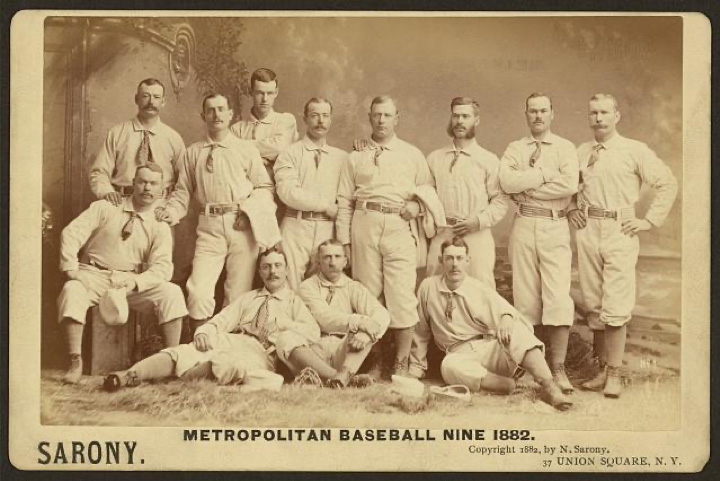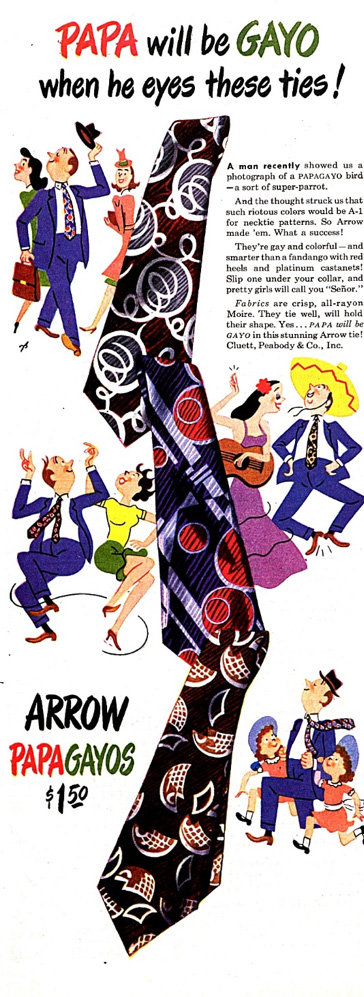Before there was the Christmas sweater, there was the Christmas tie. “Season after season, it is the No. 1 gift for men,” wrote Oren Arnold in his 1946 Post article, “How Christmas Ties Get That Way.”
In those days, every man needed a tie, at least for weddings or funerals. If he was in business or a professional line of work, he’d be expected to wear one every day, with no casual Fridays.

Ties in 1946 tended to feature loud patterns. They were the style that women preferred, and they bought most of the ties. No one knew why bold patterns were popular. Some said it was a reflection of an unsettled world: “Violent times, violent ties,” wrote Arnold. Some said it was the reaction of recently discharged G.I.s who were celebrating their return to civilian clothes.
Whatever the reason, ties were big business. With over 600 manufacturers, the tie industry was expected to reach sales of $100 million.

Today, Jim Stratte of Boxelder Inc. runs one of the very few remaining tie companies. He sees very uncertain times ahead. “All the big companies folded some time ago. Sales were down in 2018, even before COVID hit,” he says. “Now, people just aren’t wearing ties.”

He notes that even bankers and insurance executives have abandoned them. “A button-down shirt is as dressy as you need to get for the office.”
Yet one profession still seems to demand ties: sports announcers. “Football commentators are some of the best dressed Americans.”

They’ve not even worn in church anymore, he adds.
Bow ties recently enjoyed a certain vogue, but sales have slowed, says Stratte, who extended his line of ties inspired by M.C. Escher and Frank Lloyd Wright to include bows.
The modern necktie evolved from the bow tie, which evolved from the cravat, a length of fabric wrapped around the neck several times and fastened with an ostentatious bow. Since the 1870s, when the vertical necktie emerged, it was considered the mark of a “gentleman.” The two most commonly used knots were the Windsor (named after the home of the British royal family) and the Four-in-Hand (named after the practice of driving a coach harnessed to four horses — a favorite pastime of young British aristocrats in the Victorian era).
At the peak of their popularity, says Stratte, over 60 percent of men wore ties. In 2007, a Gallup poll found just 6 percent of men said they wore them.
Not coincidentally, the men’s suit is also fading away. Once the sign of having arrived, the business suit has been abandoned by executives in favor of “office casual,” and suit sales have tumbled.
Thinking about a post-tie world, Stratte wonders if there’ll be “a new accessory that’ll lets us display our personality without constricting our airways. It would be great if something better than lounge wear was around the corner.” While he admits it’s not a reliable predictor, Stratte is troubled that he doesn’t see anyone wearing ties in futuristic science fiction movies.

He admits he doesn’t always wear a tie, but he notices a difference when he does. “When I’m walking down the street wearing a tie, I feel like I’m the Jimmy Stewart of the new millennium. I feel like a good guy. The tie is my badge of honor as a gentleman and citizen. But,” he adds, “that’s stupid. No one cares.”
Does ties still make an important statement? Do they do something for men other than declare their personal tastes?
“There was a time when wearing a tie gave you something — a raised level of awareness, a heightened sense of decency, a mark of a civility that we all miss,” says Stratte.
One high school teacher who recently retired after 40 years in the classroom said he wore a tie to school every day. Asked why, he replied, “I needed to keep order in my class. It required some discipline, but it also required respect. And respect is something you have to give in order to get. And wearing a tie was my way of showing respect for my students.”
He feels it worked.
So maybe that Christmas tie you were considering for someone isn’t a bad gift idea. Says Stratte, “I personally hope the tie recovers. It was a good thing for a long time.”

Featured image: Cover by Charles Kaiser from the May 23, 1942, issue of The Saturday Evening Post
Become a Saturday Evening Post member and enjoy unlimited access. Subscribe now




Comments
I WORE MY CHRISTMAS TIE TODAY BUT I WAS THE ONLY ONE AT OUR FAMILY CHRISTMAS DINNER WHO DID. PEOPLE ALSO DON’T KNOW HOW TO DRESS ANYMORE ESPECIALLY MEN AND I HATE TENNIS SHOES AND JEANS AT A FUNERAL. TODAY MEN DON’T KNOW HOW TO DRESS. ON OCCASION I WILL EVEN WEAR A HAT. I ALSO HAVE A RACK FULL OF TIES, NICE SLACKS AND A FEW BLAZERS COATES. MY GRANDSONS DRESS FOR A SPECIAL OCASION LIKE THEY ARE COMING TO CUT MY GRASS. JUST A FEW WORDS ABOUT THE SUBJECT
This is a well-timed article, Jeff. I recently came across some copies of my originally sepia high school graduation photo I colorized myself (not the original of course), and must say the tie was/is an important part of identifying the era; along with the hair style and collar. Even pinpointing the year, or a close guess.
Men’s fashions and accessories have always paled by comparison to women’s, and now have been jettisoned in the ‘just too cool for school’ mode by many in the media elite whom most of us can’t stand for good reason, and the Republicrats in Washington who’ve driven our country into the toilet.
So ties have been made unfashionable by ties to both of these toxic factions in different ways. They were one of the important fashion accessories in the 20th century when you could tell what decade something was from, for better and worse. In this doesn’t-matter-anymore, ‘after the fact’ century, it remains to be seen what happens.
With everything becoming gender neutral anyway, it’s a safe bet clothes and hairstyles will not be much different in 2071 than now. Eventually everything flatlines. God knows it happened with music, film and most auto designs (to name 3 things) a long time ago. The tie will make some kind of comeback as it’s re-discovered as something ‘new’ even though it’s not, like vinyl albums. The costs there will see that won’t last. Ties should fare better. I get compliments on my beautiful ‘piano keys’ tie from 2020 when worn. In these times, it’s not often.